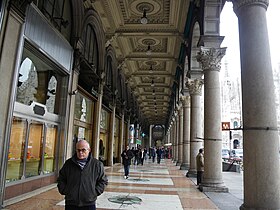Piazza del Duomo, Milan

Piazza del Duomo ("Cathedral Square") is the main (the Duomo). The piazza marks the center of the city, both in a geographic sense and because of its importance from an artistic, cultural, and social point of view. Rectangular in shape, with an overall area of 17,000 m2 (about 183,000 sq ft), the piazza includes some of the most important buildings of Milan (and Italy in general), as well some of the most prestigious commercial activities, and it is by far the foremost tourist attraction of the city.
While the piazza was originally created in the 14th century and has been gradually developing ever since (along with the Duomo, which took about six centuries to complete), its overall plan, in its current form, is largely due to architect Giuseppe Mengoni, and dates to the second half of the 19th century. The monumental buildings that mark its sides, with the main exception of the Duomo itself and the Royal Palace, were introduced by Mengoni's design; the most notable of Mengoni's addition to the piazza is the Galleria Vittorio Emanuele II arcade.
History

The origins of Piazza del Duomo can be traced back to the vision of
Azzone's successor
The next major modification of the piazza occurred in the second half of the 18th century, when architect

In the 19th century, architect Giulio Beccaria was hired by
A major twist in the piazza's evolution came about after the
Mengoni's work, in any case, was not hitchless. The company that was responsible for the works, City of Milan Improvements Company of London, eventually experienced financial problems, so that the government of Milan had to take charge. Part of the area of the Galleria was sold to private owners, with the obligation to complete the works according to Mengoni's design. In 1875, when the two Portico Palaces were finally completed, new funding problems endangered the realization of the two triumph arches that were included in the design; Mengoni eventually decided to fund the construction himself. When Mengoni died in 1877, only one of the arches, the one at the entrance of the Galleria, was completed; the construction of second arch was abandoned. Mengoni actually died in Piazza del Duomo, falling from a scaffolding while he was supervising the works.
In 1896, the statue of

The last major change to the piazza occurred during the
It will host the closing ceremony of the 2026 Winter Paralympics.
Buildings and Monuments in and around Piazza

- Duomo di Milano(Milan Cathedral)
- Galleria Vittorio Emanuele II
- Palazzo dell'Arengario
- Palazzo Carminati
- Palazzo dei Portici Settentrionali
- Palazzo dei Portici Meridionali
- Royal Palace of Milan
- Monument to King Victor Emmanuel II
Gallery
-
The Piazza in 2007
-
The square during the Christmas holidays (2008)
-
One of the arcades in the square
-
The courtyard of the Royal Palace of Milan
-
The monument toKing Victor Emmanuel IIflocked by pigeons
-
The Arcivescovado
-
ThePalazzo Carminatiand the square
-
The Monument to King Victor Emmanuel II and the Palazzo Carminati behind it
45°27′51″N 9°11′24″E / 45.46417°N 9.19000°E
External links
 Media related to Piazza del Duomo (Milan) at Wikimedia Commons
Media related to Piazza del Duomo (Milan) at Wikimedia Commons









